The Telugu speaking areas were separated from what was the composite Madras Sate, on 1st October 1953, and Andhra Pradesh came into being. Highly significant antiques are found in Andhra Pradesh bearing resemblance to various stages of development from the lower Paleolithic times.
The ancient name of Assam was Kamarupa. According to legend, Kama, the God of love, once made an effort to arouse passion in the heart of the supreme, Shiva. The meditative Shiva opened a third eye in his brow out of which leapt a flame and destroyed Kama. The compassionate God, however, later let Kama be revived.
The land where Kama got back his" rupa" or form came to be called Kamarupa.Old tribes inhabiting the area were swept away or subdued when Ahoms, a tribe that came from the upper Irravady Valley, defeated their chieftains. The domination by the Ahoms earned for the land its present name, Assam.
Internal feuds had weakened them by the early 19th century, when the Burmese overran them.Then the British began to consolidate here and revolts started against them. With the suppression of the 1857 country-wise uprising called the Sepoy Mutiny, the British were able to silence the Assamese rebels.
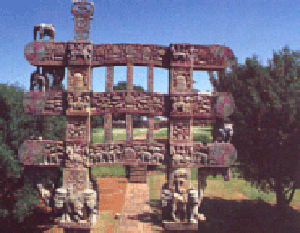
SANCHI STUPA
The antiquity of Magadha is established by the fact that it is referred in the Vedas. The kings of Magadha continued to be powerful for a along time and it was the awe inspired by them that made even the Great Alexander, to retreat.
By the closing years of the 4th century B.C., Magadha had become more powerful under the Mauryan Kings, founded by Chandragupta Maurya, whose grandson was Asoka, the Great. Although Asoka's empire was vast, his impact was felt almost over the whole of Bihar. Now, Bihar is studded with monuments that bear the memory of Mahavir Jina who resurrected Jainism, and of the Buddha. Bodhgaya, where the Buddha attained enlightment is also in Bihar. Once famous all over the world, Nalanda, the University for Buddhist studies was in Bihar too.
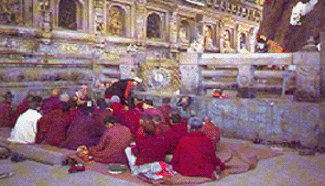
BODH GAYA
Surat is the city where the British first founded their settlement to claim the whole of India. The term Gujarat comes from the Gujaras, a tribe that settled down here in the beginning of the 5th century.
The Mahabharata mentions of Goa as Gomant. Legend says that once Parasurama, the 6th incarnation of Vishnu shot an arrow from a peak of the Sahayadri. The arrow endowed with special powers pushed the sea backwards, making Goa emerge. "Bann-Halli", meaning where the arrow fell, is the present Banaulim in Goa.
Goa has come under the rule of many historical dynasties. The Kadambas ruled the land with Chandrapura as the capital. The Bahamanis, the Mahomedan rulers of Deccan conquered Goa in 1352. Ela , on the river Mandovi became the capital. It fell in the hands of Yusuf Adil Shah, the Sultan of Bijapur. In 1510 Alfonso de Albuquerque, the second Governor of the Portuguese possessions in India, conquered it, killing the Bijapur soldiers.
In 1809, during the Napoleonic wars the British occupied Goa, but restored it to Portugal after the treaty of Vienna. In 1961, after more than 4 centuries of foreign domination, it was liberated by India.
Haryana is one of the areas of India, which has a rich cultural heritage. Kurushetra, where on the eve of the Mahabharata War, Sri Krishna enlightened Arjuna, through the Bhagavad Gita, is situated in Haryana. Haryana is mentioned in, as old scriptures as the Manusmriti. In the mythical era, it was the home of the Bharat dynasty. Ghaggar, the only river that flows in Haryana is believed to be the river Drishadvati mentioned in the Vedas.
The most important city of the region was Thaneswar. Towards the end of the 6th century it became the capital of the Pushyabuti dynasty. In the 8th century, the Huns frequently raided the areas. In 1014 Mahmud of Ghazni, invaded the region and plundered Thaneswar and many other small cities. Then came Babar, the founder of the Mughal dynasty, who won the battle of Panipat in Haryana in 1526. Some princely rulers till 1857, when the Sepoy Mutiny took place, ruled the region. Haryana was reconstituted as a separate state in 1966.
India's ancient chronicler Kalhana belonged to Kashmir. In his celebrated work, the Rajatarangini, he gives an account of the origin of Kashmir. Legend says that long long ago, Kashmir was a vast stretch of land. A demon called Jalodbhava lived in it. He went out from time to time and lay waste the lands around the lake. He had a boon as to nobody can harm unless he lived in the water.
Kasyapa, a great sage of ancient times, who knew the secret of the demon, was determined to rid the earth of him. With the help of the Gods, he had the lake struck by a mighty plough. The water was drained out and the demon lost his powers and vanished. Then emerged a wonderful land, which was called Kashyapmir, or Kashyap-mar from which the name Kashmir came into being.
Hindu Kings ruled Kashmir from the very beginning and the valley came under the rule of Asoka in the 3rd century B.C. After Asoka, a number or rulers followed and then Emperor Asoka conquered it in 1586 and the region became a part of the Mughal Empire. In 1757, Ahmad Shah Abdali of Afghanisthan conquered it. With popular support Maharaja Ranjit Singh took it over in 1819. Soon after the death of Ranjit Singh the British East India Company won a war with the Sikhs but sold it to the Raja of Jammu, Gulab Singh, for a price of 75 lakh rupees. Then, Jammu and Kashmir became one state.
The Rashrakutas ruled Karnataka from the eighth to the tenth century. When the Rashtrakutas declined, three Kannada dynasties, the Yadavas of Deogiri, Kalachuris of Kalyani and the Hoysalas of Dwarasamudra became powerful.
Then rose the famous Vijayanagar Empire, founded by Harihara and Bukka. The Empire was at its height during the reign of Krishnadevaraya.
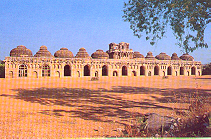
Ruins of Hampi
Karnataka, also known as Kuntala Desa in ancient times, was the home of an enterprising people who carried on trade with the Egyptians and the Sumerians. There was also close communications between the cities of Karnataka and those of the Indus Valley civilization.
Karnataka became a part of the Mauryan Empire by the 4th century. A native dynasty, known as the Satavahanas or the Satakarnis took over from the Mauryans in the 1st century B.C. Simultaneously and subsequently, the Gangas and the Chalukyas ruled parts of Karnataka. The Indian music has two great traditions, the North- Indian and the Karnatic School. Hampi is supposed to be the birthplace of the Karnatic School.
The Empire weakened and ended in the 16th century. New dynasties, the Nayaks, the Pallegars and the Wadiyars came up. Haidar Ali subdued the various chieftains and he became the Sultan in the second half of the 18th century. His conflict with the rising British power ended in the death, while fighting, of his famous son, Tipu Sultan, in 1799. The state was restored to the Wadiyar Dynasty, though it remained under the British control.
Legend says that Kerala emerged from the sea as a gift for Parasurama, the 6th incarnation of Vishnu. The length of the land is the distance covered by his axe when he hurled it.
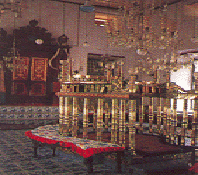
COCHIN - JEWISH SYNAGOGUE
In 1947, the state of Travancore and Cochin together with the Malabar area directly ruled by the British , formed a new state. Cranganore, Quilon, Cochin, Calicut, Kadalundi, Cannanore and Dharmadam were busy trading centers even three thousand years ago, carrying on trade with Assyrian and Babylonian Empires.
The first batch of Jews had arrived in Kerala, according to tradition, in King Solomon's ship. They had their flourishing settlement near Cochin. Kerala was also the first to welcome the Christians in India, headed by St. Thomas, the Apostle, who arrived in India within years of the death of Jesus Christ
Madhya Pradesh had been the cradle of pre-neolithic and Neolithic civilizations. Asoka, the Great, in his youth, was stationed at Ujjain in Madhya Pradesh , as the Viceroy of the Maurya dynasty over the region. Later as the promoter of Buddhism, he laid the foundation for the Sanchi Stupa, one of the famous Buddhist sites.
Later the legendary king, Vikramaditya of the Gupta dynasty ruled from Ujjain. King Yasodharaman of Malwa repulsed the Gupta Empire in the 6th century. Madhya Pradesh has many monuments and sites of historical importance associated with various dynasties. Apart from the classical culture, the tribal population also has various varied cultural strains that are unchanged for several thousand years.
Maharastra can be divided into three regions, Western Maharastra, Vidarbha and Marathwada. Vidarba was very famous in ancient times. There are numerous references to this kingdom in the Mahabharata and several other mythological works as well as in folklore. Rukmini, married to Krishna, was a princess of Vidarba.
In the 3rd century B.C., Maharastra was a part of the Mauryan Empire. As the Mauryan Empire declined, Maharastra came under the rule of various dynasties like the Satavahanas, the Traikutakas, the Vatakas, the Chalukyas and the Yadavas. Significant cultural activities continued between 3rd and 9th century A.D., during which the remarkable frescos of the Ajanta caves were made.
Towards the close of the 13th century, Maharastra came under Muslim rule. In the first part of the 17th century the great Chatrapati Shivaji emerged who gave the Marathas a new sense of unity and purpose. Early in the 19th century, Maharastra came under the British domination.
Odisha was famous as Kalinga, in ancient times. The Mahabharata describes it as the land inhabited by Rishis and the Brahma Purana calls it as the land blessed and adorned with all the virtues. Traces of Neolithic life are found here and the Juang tribe found here are the last surviving tribes among the vanishing descendants of the Stone Age.
An enterprising and affluent race inhabited Odisha and it carried on trade with Sri Lanka, Sumatra, Java, Cambodia and islands of the Pacific Sea. Asoka, the Great of the Mauryan Empire to take control of Kalinga, fought a bloody battle. The horrors of the war changed Asoka and he became a serious Buddhist.
Jainism and Buddhism flourished in Odisha with equal vigor. Hieun- Tsang, the famous Chinese traveler visited it in the 7th century. Bhubaneswar, Puri and Cuttack at different times served as the capitals of the Oriya Kings. The first Westerners to arrive in Odisha were the Portuguese, in 1514. The Dutch came in 1625. In the first decade of the 19th century, the British took possession of this state.
Punjab is believed to be the earliest Aryan settlement in India. Before the Europeans arrived, all the raiders of India arrived only through Punjab. Darius I of Persia invaded this area in the 6th century B.C. and made it a province of his Empire. In the 4th century B.C. , Alexander, the Great invaded Punjab.
Chandragupta Maurya drove out the Greek Viceroy of the province. After the decline of the Mauryan Empire, Punjab was successively raided and occupied by the Graeco-Bactrians, Sakas, Kushans and the Huns. Mahmud of Ghazni was the first Muslim invader to enter Punjab in the 10th century. A number of other Muslim invasions followed until Babar established the Mughal rule.
Towards the later phase of the decadent Mughal power the two other invaders in whose hands the Punjab suffered were Nadir Shah and Ahmad Shah Abdali. Punjab entered a new phase of history with Guru Nanak with whom began the Sikh faith (1469- 1539). Nine Gurus succeeded him. Under various historical circumstances, the Sikhs became a militant community.
The conflict between the Sikhs and the Mughals was a long story with amazing resistance showed by the Sikhs. Punjab was at its peak when King Ranjit singh ruled during 1780-1839. After his death the two wars with the rising British power gave a setback to their strength in Punjab. The British took over the Province in 1849. The whole of Punjab is strewn with monuments and places bearing the memory of the freedom struggles.
An older name of Rajasthan is Rajputana, the land of the Rajputs. Although many other racial groups are there in the state, the martial Rajputs have dominated its history through the centuries. They trace their descent to the royal dynasties mentioned in the Ramayana and the Mahabharata. The Sisodias, the Rathors, and the Kachchwas belong to the Solar line; The Bhatis and the Tanwars come from the Lunar line. The Solankis, the Parmars, the Pratihars and the Chauhans are said to have originated from a Yajna or sacrificial fire.
In the 12th century, the Rajput princes fought and checked the Muslim invasions for long. In 1526 Babur, the founder of the Mughal Empire came. Sangram singh of Mewar defied him. Mewar valiantly resisted till the time of Jahangir. Trouble started because of the religious intolerance of Aurangazeb. Then, the Mughal power declined and Rajputana could not enjoy freedom due to the attacks from the Maratha powers. This made it easy for the British to step in as the protector of the princely states of Rajasthan, 20 in all and annexed them. The princes allowed the merger of their states into the Union of India on the nation's achievement of freedom from the British.
Legend says, that following some occult sign a celebrated Tibetan Lama came to Sikkim in 1641 and met two other Lamas at Yuk- Sam, meaning, "the meeting place of the three Lamas" . Together they searched out the man destined to find a ruling dynasty over the region; he was Phutong Namgyal, the great-grandson of Guru Tashi. The three Lamas crowned him the ruler of Sikkim.
Later, though Chogyal was the chief, it was India who appointed the Prime Minister of the state and was responsible for its defence. In 1975, to fulfill the popular urge of the people of Sikkim, it was made a regular state, the 22nd of the Republic of India.
Civilization flourished in Tamilnadu long before the beginning of the Christian era. The Cheras, the cholas and the Pandyas ruled parts of the modern Tamilnadu. Thanjavur and Thiruchirapalli were identified with the Cholas and the Tirunelveli and Madurai area was identified with the Pandyas. While the Cholas first ruled from Uraiyur and then from Kaveripattinam, the Pandyas ruled from Madurai.
A third great dynasty of Tamilnadu was the Pallava dynasty of Kanchi that came to prominence in the 4th century A.D. Prosperous ports extended Tamilnadu's commerce to distant countries. The Kural by Thiruvalluvar, one of the greatest works of Indian literature written 2000 years ago, shows the growth and prosperity of Tamil in ancient times.
Pondicherry, world famous as the seat of Sri Aurobindo and the Mother, had a mystic heritage rooted in a remote past. Sage Agastya, who came from the north to South, is believed to have established his Ashram here. Though the present name comes from "Puddu Cherri", meaning New Village, it had a more ancient name, Vedapuri, suggesting that the place was known for Vedic learning.
Excavations at Arikamedu on the outskirts of the city prove that there was a Roman settlement here and regular commerce was carried on between the Port of Pondicherry and the Roman cities. The French came here following the Portuguese and the Danes, and took root here. In 1693, the Dutch bought the area from the French ruler of Gingee. Four years later, following a treaty, the French took possession of the city, with Francois Martin for its administrator.
In the 18th century, in the wake of the wars between England and France, the English in India tried to dislodge the French from Pondicherry. The city changed hands several times. Finally, the French took over in 1816 and continued here till its merger with the rest of India in 1954.
The antiquity of the civilizations, which had flourished in this soil, is well established by excavations at places like Hastinapur, Kanuaj, Kaushambi and Mathura. Many great dynasties ruled the region in mythical times. The greatest among them were the Ikshvakus. Sri Ramachandra hailed from this dynasty, ruling from Ayodhya. Historically it was a part of the Mauryan Empire. After Asoka there were kings like Pushyamitra, Kaniskha, Samudragupta, Harshavardhana, Yashovarman, Mihirbhoja and Mahipala. They all belonged to various dynasties.
In 1309, Alauddin Khilji conquered a part of the region. Muslim rulers then followed. In the 16th century, the Lodi kings made Agra their capital. Soon Babar arrived and several wars followed, and then the region became a part of the Mughal Empire. The British through the East India Company, took over the area in the 18th century. In 1857, the Sepoy Mutiny took place in a large scale in this region.
Bengal is the anglicized form of Banga, the ancient name of a part of the region. The other part was called Gauda. Both were the kingdoms in the Mauryan and the Gupta Empire. After several dynasties followed with a lot of uncertainness, the Pala kings ruled the region from the 8th century to the 12th century in a more peaceful atmosphere. In early 13th century, a Turkish General Muhammad Bhaktiyar invaded Bengal. The Buddhists of Bengal persecuted him. Intrigues marked the Muslim rule over Bengal for a long time with a brief spell of Hindu rule in the area.
In the 15th century, Sri Chaitanya, the great Vaishnav prophet appeared. In the 16th century Bengal came under the Mughal rule. In 1757, the young Nawab of Bengal, Sirajuddaula, who was disgusted with the British rule, clashed with them at the Battle of Plassey. Under Clive's leadership, the Company won because of the betrayal of Sirajuddaula's commander- in- chief, Mr. Jaffar's betrayal of his master. Siraj was soon assassinated. With the company's support, Jaffar occupied the throne of Bengal. But he was soon deposed and the Company snatched the powers from the weak successors of Jaffar. At last, Warren Hastings obliged the Nawab to retire and became the administrator of Bengal and later became the Governor- General of British India.
The sons of Bengal played a prominent part in the resurrection of India. The English education in India, started in Bengal and with the suggestion of Raja Rammohan Roy, the first English College was also set up in Calcutta in 1817.
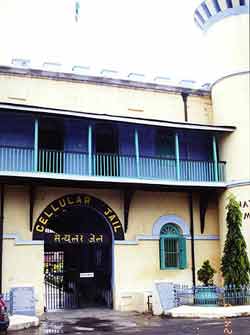
CELLULAR JAIL
The Chinese traveler Marco Polo who passed through these islands in 1290 calls them the "Angamanian Islands". Friar Odoric another European traveler in 1322 refers to the people of these islands as "Cannibals" who ate each other. But Nicolo Conti who arrived at these islands in 1440, calls these islands as the islands of Gold.
The colonizing European powers began coverting these islands from the 18th century. In 1869, they came to the possession of the British from the Dutch. For the British, the islands were for a penal settlement.
The dreaded Prison was the Cellular Jail, now a national monument. Once sent there, the prisoners were likely to die than turn back due to the unhealthy conditions that prevailed there.


